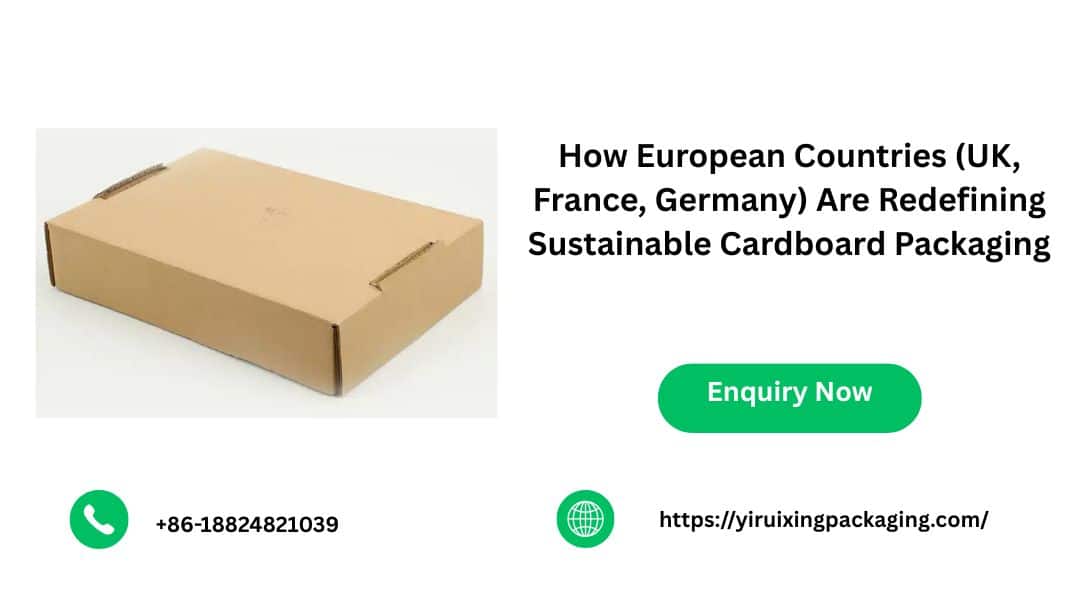Sustainability is a trend that cannot be ignored, and it is essential for brands to be sustainable if they want to remain current. In Europe, few product segments are evolving as fast as cardboard packaging. With policy changes, increasing consumer expectations, and huge investments from industry players, major European markets like the UK, France, and Germany will lead to a global shift in recyclable and sustainable packaging standards.
Table of Contents
ToggleHere is the important context of what is happening, why it matters, and how countries are establishing the future standards for custom cardboard packaging.
Why Cardboard Packaging is More Important Now Than Ever
Europe generates an incredible amount of packaging waste. Eurostat estimates that in 2023, the EU produced 79.7 million tonnes of packaging waste, which is an average of 1,392 kg (177.8 kg per person), and that 40.4% of this was paper products and cardboard. The good news is that cardboard is one of the easiest recyclable products. Cardboard is made of renewable fiber, naturally decomposes, and can be remade into new cardboard packaging. For this reason, European countries are embracing cardboard as they increase their circular economy efforts.
The UK: Innovation, Tax Pressure and Consumer Demand
The UK has quickly developed into one of the strongest cardboard-forward markets in Europe – a little bit due to regulation, but British consumers also just prefer sustainable packaging.
What is Fueling this Shift?
- The UK Plastic Packaging Tax
Implemented in April 2022, this tax applies to businesses using plastic packaging materials with less than 30% recycled content. While it doesn’t stem directly from cardboard, it has catalyzed thousands of businesses to move away from plastic and use fiber-based materials instead.
- High Recycling Rates
According to Smurfit Kappa, one of Europe’s largest paper-based packaging companies, the rates for its paper and cardboard packaging are:
- 92.5% collection rate
- 85.8% recycling rate
- Consumer Perception is Strong
According to a 2025 McKinsey study:
- 62% of UK consumers rate paper and cardboard packaging as extremely or very sustainable.
This pro-sustainability thought process means the UK will be a more perceived market for unique cardboard packaging options that can be produced with aesthetically designed and branded packaging with 100% curbside recyclability.
France: Eco-Design Laws & Ambitious Recycling Goals
France is one of the strictest countries in Europe when it comes to sustainable packaging, and its regulations are directly driving brands toward cardboard.
What are the Driving Forces?
- The Anti-Waste Law for a Circular Economy (AGEC)
This law legally requires that all packaging qualify as:
- Recyclable
- Designed to have minimal impact on the environment
- Does not include specific harmful materials
- High Paper & Cardboard Recycling Rates
As stated in a 2024 report:
- France recycles 68% of its paper and cardboard waste
- This equals 3 million tonnes each year
- EU-wide Regulations on Recyclability for Their Packaging
An upcoming EU regulation states:
- All packaging must be recyclable
- Restrictions on PFAS materials are coming
- Packaging must be clearly labeled
- 10% of all takeaway packaging should be reusable by 2030
- But French Consumers are Price Conscious
Only 41% of consumers are willing to pay for sustainable packaging, the lowest price willing to pay for sustainable packaging of the countries surveyed.
This means French brands must figure out how to combine sustainability and cost, which is available through custom cardboard packaging.
Germany: Europe’s Recycling Leader
Germany is the leader of recyclability systems; in addition, its regulations regarding packaging are among the strictest in the world.
What makes Germany different?
- The VerpackG (Packaging Act)
Manufacturers must:
- Ensure recyclability
- Contribute to dual collection systems
- Meet high material standards
- Growth of the Recyclable Packaging Industry
Germany’s recyclable packaging sector has now grown to an industry worth over $1.2 billion.
- Consumers Prefer Renewable
Germany is the only country where consumers ranked “renewable or abundant materials” as their most important sustainability preference. This is what makes cardboard packaging (which is both renewable and recyclable) a perfect fit for the German market.
The Pan-European Shift: The Future of Cardboard Packaging
Across Europe, a coordinated movement is starting to unite. New EU packaging regulations require:
- 85% recycling of cardboard by 2030
- Restrictions on harmful materials
- Common recyclability standards
- Re-use targets for certain sectors
The Economic Impact is Enormous:
According to a 2024 study, moving to 90% paper/cardboard recycling across Europe could lead to:
- 5 million tonnes of additional recycled material each year
- €1 billion economic value each year
“Throughout the UK, France, and Germany, sustainable cardboard packaging is not merely an environmentally friendly choice anymore — it is increasingly becoming the norm, fueled by consumer expectations, stringent regulations, and a collective dedication to a circular economy.”
Conclusion
Countries in Europe, like the UK, France, and Germany, are not just talking sustainability – they are changing what packaging is all about. A combination of strong regulation, smart business innovation, and consumer awareness is leading cardboard packaging to be a truly sustainable solution. And brands are increasingly able to use custom cardboard packaging, which is helping eliminate waste, reduce carbon footprints, and create circular economies – one cardboard box at a time.
FAQs
Why is custom cardboard packaging becoming so desirable?
Because it creates value through branding, sustainability, and cost efficiency. Custom cardboard packaging helps businesses reduce waste, optimize shipping, and provide a superior unboxing experience.
Are cardboard packaging regulations consistent throughout Europe?
Not entirely. EU regulations set a baseline, but each country has additional regulations that are often more rigorous.
Is cardboard better for the environment than plastic?
Yes. Cardboard is referred to as renewable, biodegradable, and recyclable. Typically, plastics are oil-dependent and degrade at a lower level of percentage than cardboard.
Which country leads Europe in sustainable cardboard packaging?
Germany leads in recycling infrastructure, the UK leads in consumer interest towards cardboard, and France leads in eco-design laws.
Will cardboard packaging be more important in the future?
Yes. EU laws, consumer demand, and corporate sustainability goals all suggest significant growth for cardboard and more customized packaging solutions.





